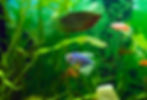
About the GloFish
Due to the bright neon colors these fish are available in, GloFish have rapidly become an extremely popular fish among beginner fish keepers. But just what are these fish exactly?
Well back in 1999 a group of scientists at the National University of Singapore were working with a gene extracted from a jellyfish that produced a bright green fluorescent coloration that they inserted into a zebra danio embryo allowing it to integrate into the fish’s genome. The fish then would be a fluorescent green under white light and ultraviolet light. They then filed a patent on their work, and next created a red fluorescent zebra danio using genes from sea coral.
Not long after the scientists from NUS and businessmen from Yorktown Technologies met and created a deal to have worldwide rights to market their new zebra danio branded as “GloFish”
So essentially GloFish are a genetically modified or GMO fish.
Since then there have been several new species of GloFish created and are now available on the market.

The GloFish now available include tetras, danios, barbs, sharks, and the newest addition, betta fish.
There have also been a few different aquariums kits created and sold by the GloFish brand that are marketed of course, to keep these GloFish in.
GloFish Hardiness
The different species of fish used to create the new GloFish version all have one thing in common, they tend to be very hardy fish that are great for beginners and can be quite forgiving when it comes to water parameters.
Unfortunately, in my years of experience taking care of them in the pet store, the GloFish don’t seem to be nearly as hardy as their original counterparts. Having said that, GloFish in stores are required to have a different set up than the original species are kept in. So is it that the fish are less hardy, or is it that they are kept in an environment that is inappropriate for that species.
The Good
Because of their brilliant bright fluorescent colors, these fish are very attractive to a younger audience. This can help to bring a new generation into the fish keeping hobby. If properly cared for they can add a nice pop of color to a well set up aquarium that children and adults can appreciate together.
The Bad
Unfortunately, many of the aquariums marketed for GloFish, are not an appropriate size for most of the species of GloFish available. With the largest GloFish aquarium available being only 10 gallons and the majority of the GloFish species needing a minimum of a 20-30 gallon tank, you can see where this could confuse people wanting to purchase these fish.
Another issue with these fish is that they were genetically modified to have bright lighting help to improve and brighten their coloration, while some of the species of fish used to create the GloFish, become stressed if kept in brightly lit tanks, with the black skirt tetra and the newest member of the GloFish family, the betta fish, being perfect examples of this.
The Truth

While some people might object to GloFish being on the market, the truth is, as long as they keep selling like crazy, they will only keep coming up with new species of GloFish. The best thing we can do is research the species they were created from and try to educate ourselves on how best to take care of that particular species and focus less on what will best show off the color of the fish.

My opinion
The GloFish themselves, to me are not a problem. Selling GloFish in itself is not something I have an issue with. The way they are marketed, however, is something I take serious issue with. The small tank sizes designed for the GloFish and the GloFish website itself, I think, is what I find most concerning.
In one spot they have it written that GloFish can be added to any community aquarium. That is wrong, some of these fish such as the barbs and the bettas, tend not to get along well with others without careful planning. They also are selling GloFish betta sorority packs of 6 female bettas, and recommending only a minimum tank size of 10 gallons. 10 gallons is not at all adequate for 6 female bettas and they also state that the female bettas can be kept with TIGER BARBS!!!
Tiger barbs are known to be extremely aggressive fin nippers and it is not recommended to keep them with bettas. Has it ever been done successfully, yes, but does it usually work, NO! Best case scenario, the tiger barbs would just out-compete the betta for food. They also recommend you keep a minimum of 5 barbs with 1 gallon of water per barb kept. You cannot keep 5 tiger barbs in a 5 gallon tank. The MINIMUM recommended tank size for tiger barbs is 20 gallons, but many would argue it should be 30.